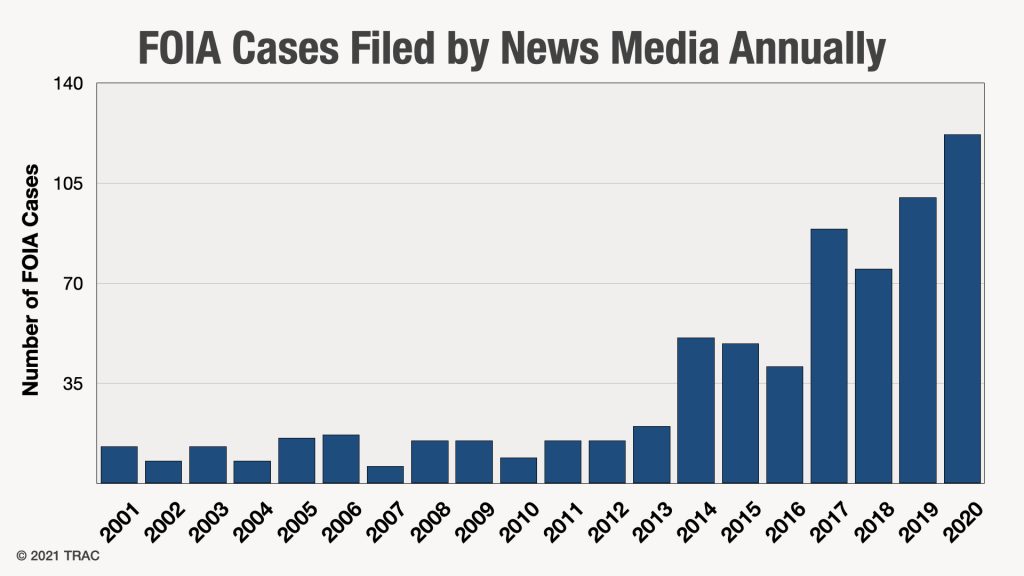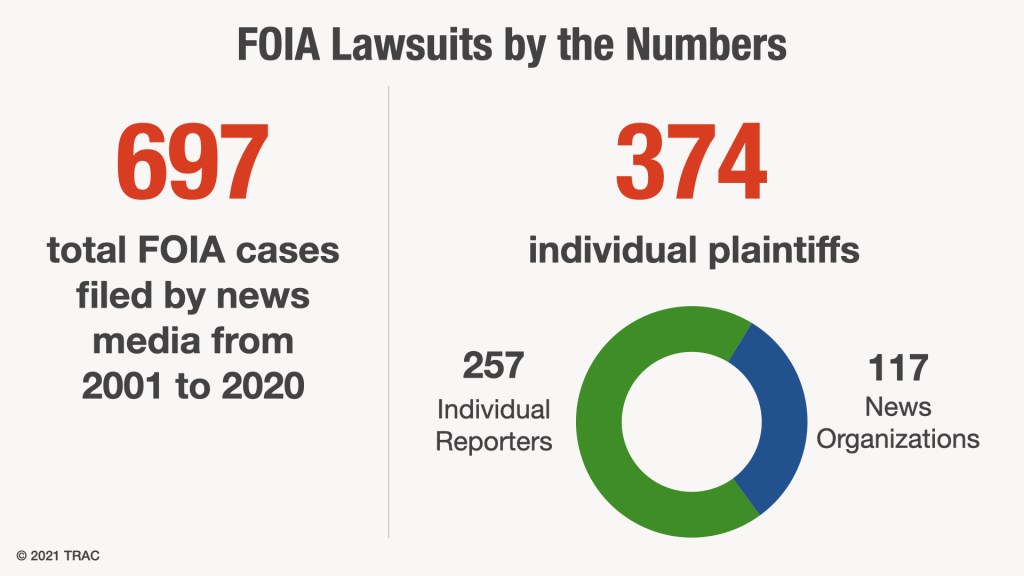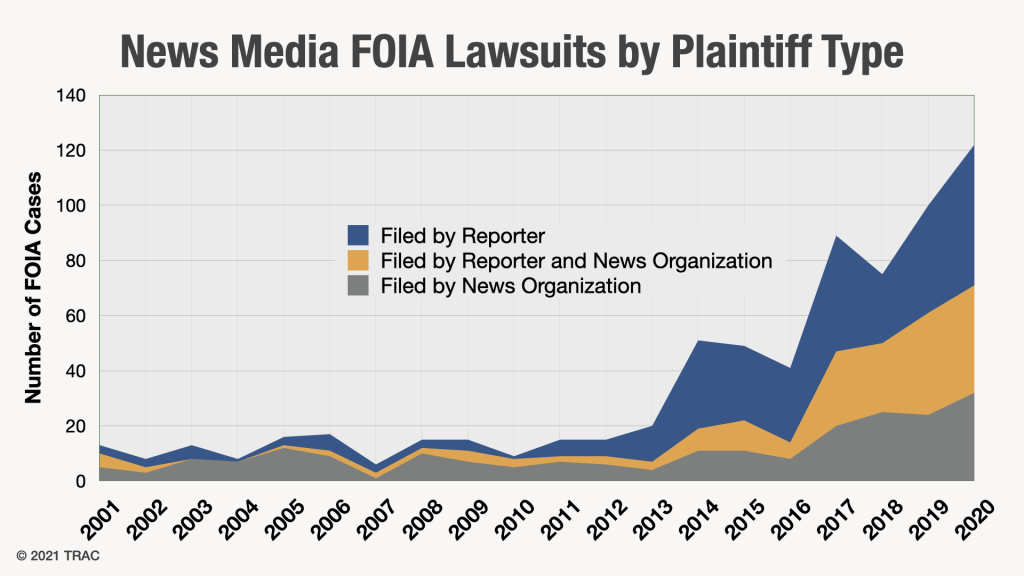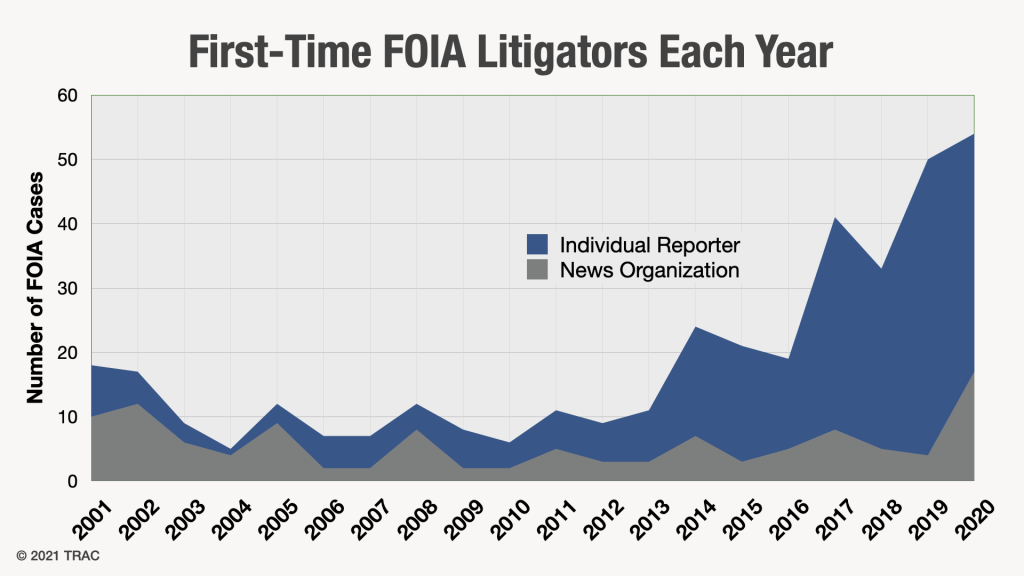When FOIA Goes to Court: 20 Years of Freedom of Information Act Litigation by News Organizations and Reporters
The news media are powerful players in the world of government transparency and public accountability. One important tool for ensuring public accountability is through invoking transparency mandates provided by the Freedom of Information Act (FOIA). In 2020, news organizations and individual reporters filed 122 different FOIA suits[1] to compel disclosure of federal government records—more than any year on record according to federal court data back to 2001 analyzed by the FOIA Project.
In fact, the media alone have filed a total of 386 FOIA cases during the four years of the Trump Administration, from 2017 through 2020. This is greater than the total of 311 FOIA media cases filed during the sixteen years of the Bush and Obama Administrations combined. Moreover, many of these FOIA cases were the very first FOIA cases filed by members of the news media. Almost as many new FOIA litigators filed their first case in court in the past four years—178 from 2017 to 2020—than the years 2001 to 2016, when 196 FOIA litigators filed their first case. Reporters made up the majority of these. During the past four years, more than four out of five of first-time litigators were individual reporters. The ranks of FOIA litigators thus expanded considerably during the Trump Administration, with more reporters challenging agencies in court for failing to provide records they are seeking, either alone or with their news organizations.
Using the FOIA Project’s unique dataset of FOIA cases filed in federal court, this report provides unprecedented and valuable insight into the rapid growth of media lawsuits designed to make the government more transparent and accountable to the public. The complete, updated list of news media cases, along with the names of organizations and reporters who filed these suits, is available on the News Media List at FOIAProject.org. Figure 1shows the total number of FOIA cases filed by the news each year. Counts are available in Appendix Table 1 at the end of this report.

FOIA Lawsuits by the Numbers
This report focuses on news media “FOIA litigants” (a.k.a. “FOIA plaintiffs”). These include both traditional news organizations and alternative news sources when their primary purpose is to be a news source. News reporters, including freelancers, are also included when this is their primary profession.[2] Suits can be filed by either or brought jointly by the reporter and their news organization.[3] Finally, because this data set only includes FOIA cases from calendar years 2001 to 2020, cases filed by plaintiffs prior to 2001 are not covered.[4]
The FOIA Project’s analysis found that since January 1, 2001, the news media has filed a total of 697 separate FOIA cases in federal court. Looking at these cases reveals 374 distinct plaintiffs, 117 news organizations and 257 individual reporters.

Of the 697 suits, 300 or 43 percent were brought by a reporter alone. An additional 182 were filed jointly by reporters with their news organizations. Less than a third (31%) or just 215 out of the 697 suits were filed by news organizations alone, where reporters were not included as plaintiffs on the suits.
Individual Reporters Drive Growth in FOIA Cases
FOIA lawsuits filed by news organizations and individual reporters began to climb in 2013 during the second half of the Obama Administration, fueled by reporters bringing suits themselves during this initial surge.[5] As cases continued to increase after President Trump took office, reporters filing alone became a smaller share of the total as reporters joined forces with their news organizations to bring lawsuits. See Figure 3 below. Counts are found in Appendix Table 1 in the appendix of this report.

Going to Court for the First Time
Understanding when FOIA litigators file their first lawsuit and whether they file subsequent lawsuits provides insight into how much of the growth of cases is driven by new litigators. For many years, FOIA litigators remained a relatively small and specialized group in the news media world. As Figure 4 below illustrates, from 2003 to 2013, only about 10 or fewer new litigators filed their first case each year. After 2013, the number of new media organizations remained low, but the number of individual reporters filing their first FOIA cases trended upward dramatically, from just 8 in 2013 to a peak of 46 reporters in 2019. These data show that the community of FOIA litigators within the media expanded and diversified considerably since 2013. Appendix Table 2 provides the number and percentages of first-time litigators.
By contrast, although the total number of FOIA lawsuits filed by media organizations grew overall from 2013 to 2019 (see Figure 4), this was a sign that media organizations were filing more lawsuits per organization, not necessarily that new media organizations were getting involved in FOIA litigation work. In fact, the number of new media organizations in court remained below 10 each year through 2019. However, in 2020, 17 media organizations filed their very first FOIA case in court—more than a four-fold jump from the year before, when there were only four new media organizations and the highest since 2001.[6] These data show that, although delayed compared to individual reporters, early signs are that the number of different media organizations may also be growing.

Top 10 FOIA Litigators
Out of the 374 individual plaintiffs, a few key FOIA litigators rise to the top. While frequent filers make up a relatively small proportion of the list, they account for a much larger share of the suits filed. The top ten filers make up less than three percent of all plaintiffs, yet they accounted for 281 of the 697 FOIA cases—40 percent of the total suits filed. Table 1 lists the top 10 FOIA litigators based on the number of lawsuits in which each plaintiff has been involved.
First on the list, The New York Times Company filed 77 federal FOIA cases since its first entry in FOIA Project’s records in 2003. The New York Times has filed at least one FOIA case each year from 2006 to present, including 41 cases during the Trump Administration alone. In just 16 (or 21%) of their FOIA cases, The New York Times was listed as the sole plaintiff. In four out of five cases, the New York Times is listed alongside other plaintiffs. Charlie Savage, also in the top ten, is named in 26—or one-third—of The New York Times’ cases, which also puts Savage at number six in the top ten most active FOIA litigators. The New York Times’ various co-plaintiffs include peer media organizations such as the Associated Press and NBC News, as well as well-known reporters such as Julia Preston and Matthew Rosenberg.
Coming in at a close second, Jason Leopold has been involved in 69 FOIA cases since 2012, by far the most active individual FOIA litigator in the United States today. Prior to hiring Leopold in 2017, BuzzFeed had only filed one FOIA case in 2014. But since 2017, BuzzFeed has risen quickly to the top with 59 total FOIA cases—now the second most active media organization and third overall. So far, Leopold and BuzzFeed have filed 31 FOIA cases together as co-plaintiffs, but both Leopold and BuzzFeed continue to file separate cases, too. BuzzFeed has filed 28 additional FOIA cases without Leopold as a co-plaintiff, and Leopold has filed another 38 cases without BuzzFeed as a co-plaintiff. In fact, BuzzFeed has been involved in more FOIA litigation—58 cases—during the Trump Administration than any other entity.
The Center for Public Integrity comes it at number four with 30 total FOIA cases, and the Center for Investigative Reporting comes in closely behind at number five with 28 total FOIA cases. The Center for Public Integrity has been involved in FOIA litigation for longer, with cases going back as far as 2003. However, the Center for Investigation Reporting, despite its recent entry into FOIA litigation (its first case was only in 2017), has quickly caught up by filing twice as many FOIA cases during the Trump Administration as the Center for Public Integrity—28 compared to 14.
National Public Radio comes in at number seven with 17 FOIA cases—all of which were filed during the Trump Administration. Tied at number eight, the Daily Caller filed 12 FOIA cases altogether, eight just in the past four years. Also tied for 8th place, David Burnham, former New York Times investigative reporter and now co-director of the Transactional Records Access Clearinghouse (TRAC) has been involved with 12 FOIA cases stretching back to 2002. The Washington Post comes in 10th with ten cases total, three in 2020 alone.
| Rank | FOIA Plaintiff | Total Cases |
|---|---|---|
| 1 | The New York Times Company | 77 |
| 2 | Jason Leopold | 69 |
| 3 | BuzzFeed, Inc. | 59 |
| 4 | Center for Public Integrity | 30 |
| 5 | Center for Investigative Reporting | 28 |
| 6 | Charlie Savage | 26 |
| 7 | National Public Radio, Inc. | 17 |
| 8 | Daily Caller News Foundation | 12 |
| 8 | David Burnham | 12 |
| 10 | Washington Post | 10 |
Rising FOIA Stars
Looking only at the top ten FOIA litigators since 2001 could obscure the work of news organizations and reporters who have recently become active in the FOIA litigation space. In fact, almost all of the most active FOIA litigators during the Trump Administration only filed their first cases in the past four years. For example, individual reporters Jimmy Tobias, Benjamin Wittes, and Freddy Martinez have each filed several cases already despite appearing only recently in the FOIA Project’s News Media List. Likewise, NBC News, ABC News, and CNN had no record of filing any cases between 2001 and 2017, but each filed multiple cases in the past four years. See Table 2 below for a list of FOIA news media plaintiffs listed on three or more FOIA lawsuits during the Trump Administration.[7]
| Plaintiff | Type | FOIA Cases Filed | First Year of Filing* | |
|---|---|---|---|---|
| During Trump Administration |
2001-2020 | |||
| BuzzFeed, Inc. | Media Organization | 58 | 59 | 2014 |
| The New York Times Company | Media Organization | 41 | 77 | 2003 |
| Jason Leopold | Reporter | 35 | 69 | 2012 |
| Center for Investigative Reporting | Media Organization | 28 | 28 | 2017 |
| National Public Radio, Inc. | Media Organization | 17 | 17 | 2017 |
| Center for Public Integrity | Media Organization | 14 | 30 | 2003 |
| Charlie Savage | Reporter | 12 | 26 | 2010 |
| Jimmy Tobias | Reporter | 9 | 9 | 2018 |
| Daily Caller News Foundation | Media Organization | 8 | 12 | 2015 |
| Benjamin Wittes | Reporter | 8 | 8 | 2017 |
| Freddy Martinez | Reporter | 8 | 8 | 2019 |
| Noah Shachtman | Reporter | 8 | 8 | 2017 |
| Pro Publica, Inc. | Media Organization | 7 | 9 | 2014 |
| Washington Post | Media Organization | 6 | 10 | 2005 |
| Joshua Phillips | Reporter | 6 | 7 | 2003 |
| Rukmini Callimachi | Reporter | 6 | 6 | 2020 |
| Josh Gerstein | Reporter | 5 | 8 | 2003 |
| Scott R. Anderson | Reporter | 5 | 5 | 2018 |
| Eric Westervelt | Reporter | 4 | 4 | 2018 |
| NBC News | Media Organization | 4 | 4 | 2019 |
| David Burnham | Reporter | 3 | 12 | 2002 |
| Charles Seife | Reporter | 3 | 8 | 2011 |
| Dow Jones & Company, Inc. | Media Organization | 3 | 4 | 2001 |
| David Codrea | Reporter | 3 | 4 | 2015 |
| First Look Media Works, Inc. | Media Organization | 3 | 4 | 2016 |
| Gannett Co., Inc. | Media Organization | 3 | 4 | 2016 |
| Brad Heath | Reporter | 3 | 3 | 2017 |
| Kenneth P. Vogel | Reporter | 3 | 3 | 2017 |
| Cable News Network, Inc. | Media Organization | 3 | 3 | 2017 |
| Mark Sauter | Reporter | 3 | 3 | 2017 |
| Raymond Bonner | Reporter | 3 | 3 | 2017 |
| Patrick Michels | Reporter | 3 | 3 | 2018 |
| Lance Williams | Reporter | 3 | 3 | 2018 |
| Will Evans | Reporter | 3 | 3 | 2018 |
| Adam Entous | Reporter | 3 | 3 | 2019 |
| Tim Mak | Reporter | 3 | 3 | 2019 |
| ABC News | Media Organization | 3 | 3 | 2020 |
| Kohl Harrington | Reporter | 3 | 3 | 2020 |
| Lee Fang | Reporter | 3 | 3 | 2020 |
* Represents first year during the 2001-2020 period.
One-Time FOIA Litigators
The majority of plaintiffs (71% or 266) filed just one lawsuit. Two-thirds of these filed their suit in the last five years. The remaining one-third (32% or 118) of the plaintiffs filed their single FOIA lawsuit more than five years ago, and never returned to court. This included 51 news organizations and 67 reporters.
Some plaintiffs that filed FOIA cases in the past have not filed any new FOIA cases recently. Out of 374 plaintiffs in these data, 136 plaintiffs (or 36% of the total) have no record of filing any FOIA cases in the past five years, including 77 reporters and 59 news organizations. This includes several media organizations and reporters who filed multiple FOIA cases in the past, such as the San Francisco Bay Guardian (6)[8], Fox News Network, LLC (5), Prison Legal News (5)[9], George Lardner, Jr. (4)[10], Los Angeles Times Communications, LLC (4), Detroit Free Press, Inc. (3), Mattathias Schwartz (3), and Shane Bauer (3).
FOIA Cases are Concentrated in Three Federal Courts
Federal FOIA cases filed by the media are concentrated in just a few federal court districts. Almost six in ten FOIA cases (58.5%) are filed in Washington, D.C.—not surprising since the primary defendant in federal FOIA cases are federal agencies that are often based in the nation’s capital. In fact, FOIA statute allows any FOIA suit to be filed in D.C. even if neither the plaintiff nor the requested records are physically located there. An additional 18.8 percent of cases are filed in the Southern District of New York, while 8.0 percent are filed in the Northern District of California. Table 3 below shows the top five federal court districts by total FOIA cases.
| Federal Judicial District | Number of FOIA Cases | Percent of Total |
|---|---|---|
| District of Columbia | 408 | 58.5% |
| Southern District of New York | 131 | 18.8% |
| Northern District of California | 56 | 8.0% |
| Central District of California | 12 | 1.7% |
| Eastern District of New York | 9 | 1.3% |
| Other | 81 | 11.6% |
| Total | 697 | 100.0% |
Appendix
| Calendar Year |
Plaintiff(s) Filing Case | |||
|---|---|---|---|---|
| Total | Individual Reporter |
News Organization |
Reporter with News Organization |
|
| 2001 | 13 | 3 | 5 | 5 |
| 2002 | 8 | 3 | 3 | 2 |
| 2003 | 13 | 5 | 8 | 0 |
| 2004 | 8 | 1 | 7 | 0 |
| 2005 | 16 | 3 | 12 | 1 |
| 2006 | 17 | 6 | 9 | 2 |
| 2007 | 6 | 3 | 1 | 2 |
| 2008 | 15 | 3 | 10 | 2 |
| 2009 | 15 | 4 | 7 | 4 |
| 2010 | 9 | 1 | 5 | 3 |
| 2011 | 15 | 6 | 7 | 2 |
| 2012 | 15 | 6 | 6 | 3 |
| 2013 | 20 | 13 | 4 | 3 |
| 2014 | 51 | 32 | 11 | 8 |
| 2015 | 49 | 27 | 11 | 11 |
| 2016 | 41 | 27 | 8 | 6 |
| 2017 | 89 | 42 | 20 | 27 |
| 2018 | 75 | 25 | 25 | 25 |
| 2019 | 100 | 39 | 24 | 37 |
| 2020 | 122 | 51 | 32 | 39 |
| Total | 697 | 300 | 215 | 182 |
| Number of First-Time FOIA Litigators | Percent of First-Time FOIA Litigators | ||||
|---|---|---|---|---|---|
| Calendar Year |
News Organization |
Individual Reporter |
Total | News Organizations |
Individual Reporters |
| 2001 | 10 | 8 | 18 | 56% | 44% |
| 2002 | 12 | 5 | 17 | 71% | 29% |
| 2003 | 6 | 3 | 9 | 67% | 33% |
| 2004 | 4 | 1 | 5 | 80% | 20% |
| 2005 | 9 | 3 | 12 | 75% | 25% |
| 2006 | 2 | 5 | 7 | 29% | 71% |
| 2007 | 2 | 5 | 7 | 29% | 71% |
| 2008 | 8 | 4 | 12 | 67% | 33% |
| 2009 | 2 | 6 | 8 | 25% | 75% |
| 2010 | 2 | 4 | 6 | 33% | 67% |
| 2011 | 5 | 6 | 11 | 45% | 55% |
| 2012 | 3 | 6 | 9 | 33% | 67% |
| 2013 | 3 | 8 | 11 | 27% | 73% |
| 2014 | 7 | 17 | 24 | 29% | 71% |
| 2015 | 3 | 18 | 21 | 14% | 86% |
| 2016 | 5 | 14 | 19 | 26% | 74% |
| 2017 | 8 | 33 | 41 | 20% | 80% |
| 2018 | 5 | 28 | 33 | 15% | 85% |
| 2019 | 4 | 46 | 50 | 8% | 92% |
| 2020 | 17 | 37 | 54 | 31% | 69% |
| Total | 117 | 257 | 374 | 31% | 69% |
Footnotes
[1] The download for FY 2020 cases on which this report is based covered January 1 through December 27. If the period had gone through December 31, the actual count would be one higher — 123 rather than 122 given a further suit filed on December 28, 2020. Table 2 has been updated to credit Noah Shachtman, Editor in Chief of The Daily Beast, with that filing.
[2] This list does not include everyone who may qualify for lowered processing fees with media status as currently defined under the FOIA statute, and therefore does not include data from FOIA cases filed by non-media organizations and individuals who are not reporters. For related information, see the FOIA Projects “Nonprofit List,” which contains FOIA lawsuit filers among nonprofits including nonprofit advocacy groups.
[3] Adding to the complexity, plaintiffs can file a case alone or jointly, and a single plaintiff can be involved in several FOIA cases. Because the data for this report focuses only on media plaintiffs, co-plaintiffs that do not identify as news media are not included. These are often scholars or nonprofit organizations seeking the information to pursue research, educational, or advocacy goals.
[4] The FOIA Project’s data includes filings going back to October 1, 1992. Classifying plaintiffs by type of requester is a manual process and this has been systematically completed for news media requesters back through FY 2001.
[5] For more information, see our previous report titled “Media Lawsuits Seeking Government Records Jump Under Trump” released in August 2018.
[6] The remarkable number of new media organizations getting involved in FOIA litigation is even more dramatic, since the first few years of data on “first-time” litigators will necessarily over-represent first-timers.
[7] Identifying “first time” filers for media organizations can present challenges. When the media organization undergoes a name change, or where a local affiliate files in its own name, these may appear as first-time filers in our listings even though the predecessor or parent company has been previously active as a FOIA litigator.
[8] The San Francisco Bay Guardian shut down in 2014, but later relaunched as an online publication.
[9] The Prison Legal News evolved into a part of a larger Human Rights Defense Center, a 501c3 non-profit organization, which continued to file FOIA suits but under that name.
[10] George Lardner, a Pulitzer Prize winner, passed away in 2019.
